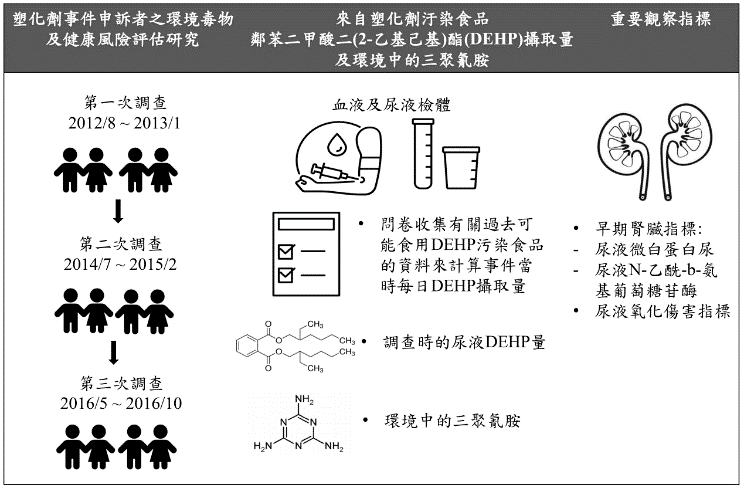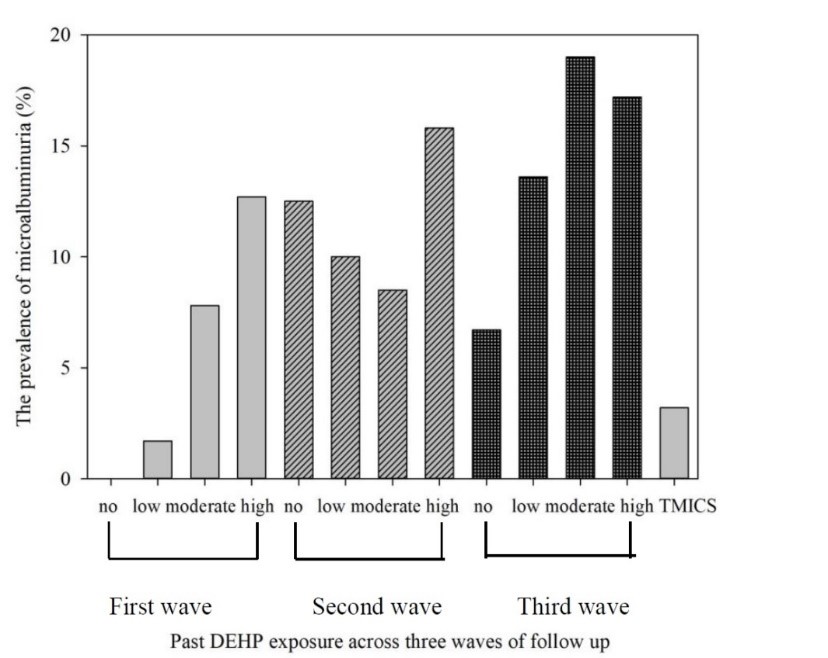塑化劑汙染食品與生活環境三聚氰胺暴露對2011年塑化劑事件年輕申訴者的早期腎臟傷害指標的衝擊
塑化劑汙染食品與生活環境三聚氰胺暴露對2011年塑化劑事件年輕申訴者的早期腎臟傷害指標的衝擊
慢性腎臟病已被公認為全球最重要的公共衛生問題並且也是台灣十大死因之一。台灣的慢性腎臟病發生率為11.9%,並且在過去十年中仍逐漸增加,雖然其成因除了已知的衰老,高血壓和糖尿病等危險因子外,其他環境因子特別是日常生活中接觸到的塑化劑及三聚氰胺等物質,則較少被探討其與腎臟疾病形成之關聯性。眾所皆知,台灣於2011年5月爆發塑化劑食品汙染事件,許多孩童因長期誤食含有高劑量塑化劑的食品及保健食品等,其中最主要為鄰苯二甲酸二(2-乙基己基)酯(di-(2-ethylhexyl) phthalate;簡稱DEHP)。國家衛生研究院群體健康研究所與高雄醫學大學環境醫學研究中心的研究團隊在2012年共同合作建立全國「塑化劑等環境毒素對健康危害之防治-塑化劑高暴露族群之中長期追蹤研究」,針對200位當時可能暴露於DEHP汙染食品的年輕族群(≤ 18歲)於五年內進行三次的身體健康檢查追蹤與生物檢體收集(包括尿液)(圖A),研究結果發現汙染食品中含DEHP愈高會增加兒童微量白蛋白尿的風險,雖此影響在第二次追蹤調查中短暫減弱,但在第三次追蹤調查中仍發現汙染食品DEHP對兒童微量白蛋白尿的影響持續存在(圖B及圖C),而且接觸生活環境中三聚氰胺愈多,則其尿中微量白蛋白尿的風險更高。另外,我們也發現此「塑化劑高暴露族群」其微量白蛋白尿的異常率遠高於來自「台灣婦幼世代研究;簡稱TMICS」的一般健康兒童(異常率約3-5%,圖B)。這些結果表示仍需對此高風險族群進行持續的健康監測和追蹤,並衛教他們減少生活環境潛在性腎毒物的暴露。
【主要研究者】
論文第一作者是醫學院助理教授蔡惠如醫師,通訊作者為精準環境醫學研究中心吳明蒼特聘教授;此研究成果來自全國「塑化劑等環境毒素對健康危害之防治-塑化劑高暴露族群之中長期追蹤研究」的研究資料。感謝國家衛生研究院熊昭名譽研究員、王淑麗研究員、陳主智研究員,及黃柏菁副研究員,國立陽明交通大學陳美蓮教授,國立聯合大學吳佳芳助理教授,以及高雄醫學大學李建宏教授、謝慧敏教授、與醫學院陳百薰教授的協助。
【研究聯繫Email】
bankin_0920@yahoo.com.tw; 960021@kmuh.org.tw
(A)

(B)

(C)

Temporal changes of early renal injury in children exposed to DEHP and melamine in the 2011 Taiwan food scandal- A three-wave follow-up study
Temporal changes of early renal injury in children exposed to DEHP and melamine in the 2011 Taiwan food scandal- A three-wave follow-up study
Chronic Kidney disease (CKD) is one of tenth death causes in Taiwan. The etiology of CKD is multifactorial. Besides the well-known risk factors such as hypertension and diabetes mellitus, some emerging environmental chemicals have been considered as the additional culprits for early of renal injury. In 2011, phthalates, mainly di-(2-ethylhexyl) phthalate (DEHP), were found to have been added to a variety of foods in Taiwan. This prospective cohort study aims to investigate the interactive effect of exposure to DEHP-tainted foods and environmental melamine exposure on early markers of renal injury in children from the 2011 Taiwan Food Scandal through three-wave follow-up surveys. Two hundred possibly DEHP-affected children (aged £ 18 years) were enrolled in the first survey wave (August 2012-January 2013), with 170 and 159 children in the second (July 2014-February 2015) and third waves (May 2016-October 2016), respectively (Figure A). The first wave was consisted of questionnaires used to collect data about possible past DEHP exposure from DEHP-tainted foods. One-spot overnight morning urine samples were collected to measure melamine levels, phthalate metabolites, and markers of renal injury (albumin/creatinine ratio (ACR) and N-acetyl-beta-D-glucosaminidase) in all three waves. Using the statistical analysis of Generalized Estimating Equation, we found that both past DEHP exposure and time might affect urinary ACR (Figure B and C). Urinary melamine levels were also correlated significantly with urinary ACR. The highest impact associated with exposure to DEHP-tainted foods in increasing urinary ACR of children was observed during the first wave, and the effect may partially diminish over time. In addition, the prevalence of microalbuminuria (defined as urinary ACR > 3.5 mg/mmol) was much higher in this study cohort, when compared to healthy children (~3-5% microalbuminuria) from Taiwan Maternal and Infant Cohort Study (TMICS) (Figure B). The results recommend that continuous monitoring of renal health and other long-term health consequences and how to avoid potential nephrotoxic chemicals from the general environment are mandatory in the susceptible young population affected by the scandal in 2011.
Introduction of main authors
The first author and corresponding author of this article are Dr. Hui-Ju Tsai, an assistant professor from College of Medicine, Kaohsiung Medical University (KMU) and Dr. Ming-Tsang Wu, a distinguished professor from Research Center for Precision Environmental Medicine, KMU, respectively. The research data was from a nationwide longitudinal health survey, named the Risk Assessment of the Phthalate Incident (RAPIT), formed by the collaboration of scientists from both KMU and National Health Research Institutes (NHRI). We thank Drs. Chao A. Hsiung, Shu-Li Wang, Chu-Chih Chen, Po-Chin Huang, Yin-Han Wang, and Yuh-An Chen from NHRI, Dr. Mei-Ling Chen from National Yang Ming Chiao Tung University, Dr. Chia-Fang Wu from National United University, and Drs. Chieng-Hung Lee, Hui-Min Hsieh, and Bai-Hsiun Chen from KMU.
Main authors’ email:
bankin_0920@yahoo.com.tw; 960021@kmuh.org.tw
Citation:
Tsai HJ, Wu CF, Hsiung CA, Lee CH, Wang SL,Chen ML, Chen CC, uang HuaHuang PC, Wang YH, Chen YA, Chen BH, Chuang YS, Hsieh HM, Wu MT*: Longitudinal changes in oxidative stress and early renal injury in children exposed to DEHP and melamine in the 2011 Taiwan food scandal Environ Int 2022 Jan;158:107018. doi: 10.1016/j.envint.2021.107018.
(A)

(B)

(C)





